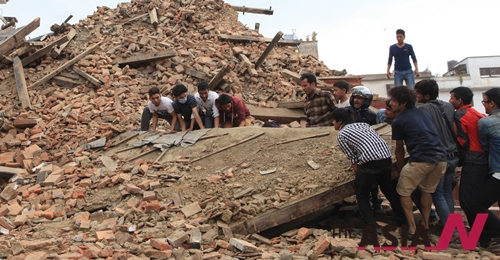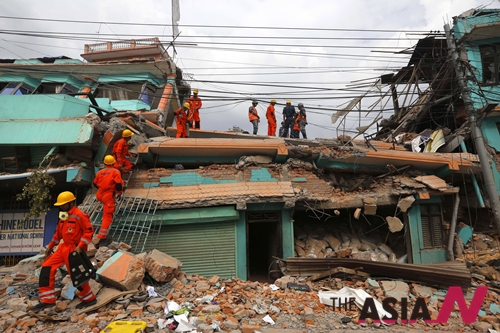Earthquake in Nepal: Rubbles, dust and corpses

In this April 25, 2015 photo, people try to lift the debris from a temple at Hanumandhoka Durbar Square after an earthquake in Kathmandu, capital of Nepal, Saturday, April 25, 2015. A strong earthquake shook Nepal’s capital and the densely populated Kathmandu Valley before noon Saturday, causing extensive damage with toppled walls and collapsed buildings, officials said.<Photo=AP/Newsis>
[AsiaN=Rahul Aijaz] On Saturday 25th April, just before noon, a 7.8-magnitude earthquake struck the mountainous country of Nepal, killing more than 3,200 people and injuring over 6000. On Sunday, the country was struck by a major aftershock at magnitude-6.7, adding to the ever-rising death toll.
The earthquake was powerful enough to disturb the mountains in Nepal as well as affect neighboring countries including Pakistan, India, Bangladesh and Tibet. At least 17 were killed and 61 injured in the base camp of Mt. Everest, where the quake launched an avalanche. The aftershock triggered more avalanches and shook the glaciers. At least another 61 died from the quake in India and neighboring countries.
The quake, centered outside Kathmandu, was the worst to hit the South Asian nation in 80 years. It destroyed many neighborhoods in the capital city, severely damaged many temples and weakened buildings. Over 700 people died in Kathmandu alone.
A number of historic landmarks also collapsed. Among those was the Dharahara Tower (one of Kathmandu’s landmarks built by Nepal’s royal rulers in 1800s), some temples and parts of what was once a royal palace, listed as UNESCO world heritage site.
Rescuers and international teams spent Sunday digging through the wreckage of bricks, concrete slabs, iron beams and wood to find survivors. Because of the chalky dust-fused air, people wore breathing masks.

India’s National Disaster Response Force personnel look for survivors in a building, in Kathmandu, Nepal, Sunday, April 26, 2015. Sleeping in the streets and shell-shocked, Nepalese cremated the dead and dug through rubble for the missing Sunday, a day after a massive Himalayan earthquake devastated the region and destroyed homes and infrastructure. <Photo=AP/Newsis>
The aftermath of the disaster has seen many people trying to leave Nepal due to safety reasons. One of those fleeing, along with his wife and daughter, said they were leaving with heavy hearts.
“It was a very difficult decision. I have called this home for seven years. But you have to think about the family, about your child.”
The quake is sure to affect the country’s economy as the impoverished nation mainly depended on tourism, especially Mount Everest, which is world’s highest mountain.
Nepali Information Minister Minendra Rijal said that there had been massive damage. “We need support from the various international agencies which are more knowledgeable and equipped to handle the kind of emergency we face now.”
The US is sending a disaster response team to Nepal and has released an initial $1m (£0.7m) to address immediate needs, the US aid agency USAid has said. The UK government has announced that it will donate £5m to help the rescue effort in Nepal. Other countries like Pakistan, India, Sri Lanka and China have also sent rescue teams and relief assistance to the quake-struck country.
Rescuers are digging through the rubble of collapsed structures, finding bodies and possible trapped survivors. Cell phones and other communication ways have been disrupted, and people have been spending their time on the streets, due to fear of further aftershocks. With nowhere to go, tens of thousands of survivors spent the nights on streets.
The earthquake was the worst in the nation’s history since 1934.












































